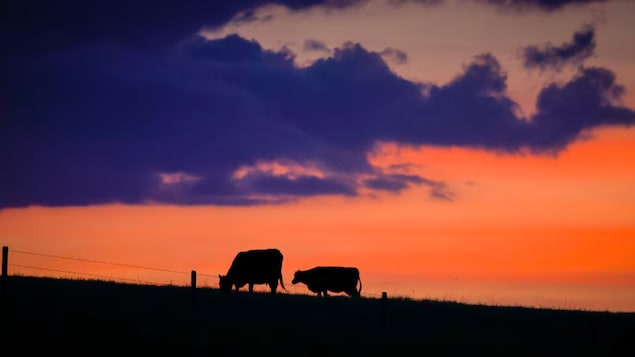- Home
- Science
Scientists warn Canada ’way behind the virus’ as bird flu explodes among U.S. dairy cattle

Avian flu testing will be required for cattle that cross from the U.S. into Canada, among other requirements, said the Canadian Food Inspection Agency. But scientists say Canada needs more proactive surveillance as H5N1 explodes south of the border.
Photo: (Jeff McIntosh/The Canadian Press)
Calls for active surveillance on both sides of the border after H5N1 spreads across 9 states
While federal officials say there's still no sign of a dangerous form of bird flu in Canadian dairy cows, scientists warn limited surveillance means Canada might not be staying ahead of an explosive H5N1 outbreak among dairy cattle south of the border.
So far, dozens of herds across various U.S. states have been infected with this form of influenza A. While it appears to cause milder infections in cows, H5N1 has also been linked to stunning death rates of 50 per cent or more in other species, including various birds, cats and even humans (new window), though more data and research is needed to fully understand the risks.
I think we're way behind the virus,
warned Matthew Miller, an immunologist and vaccine developer with McMaster University, who's among the Canadians working on H5N1 research.
Without a robust national surveillance program, there's no way to know if there are infections here or not.
The Canadian Food Inspection Agency (CFIA) told CBC News on Monday it has not detected this form of bird flu yet in dairy cattle — or any other livestock — in Canada. (In birds, however, the disease is already widespread (new window) across (new window) the country (new window), impacting an estimated 11 million farmed birds (new window) to date.)
The disease is federally reportable in any species, cattle included, the CFIA said. The agency requires dairy producers to monitor for signs of infection, follow biosecurity measures, and contact their local CFIA office if there is a high degree of suspicion
of the disease.
It appears that cross-country trade is still allowed. Asked whether dairy cattle can currently be transported between the U.S. and Canada, the CFIA said the World Organisation of Animal Health does not recommend restrictions on the movement of healthy cattle and their products at this time.
As well, following a U.S. federal order last Wednesday requiring H5N1 testing for many dairy cattle moving between states, Canada will also require testing for [avian flu] on imported lactating dairy cattle from the U.S.,
the CFIA said.
When asked about testing milk samples, the agency said if H5N1 is detected in Canadian cattle, it will help provide testing support.
(The agency was more clear in an earlier statement on social media (new window), saying it is not currently testing raw or pasteurized milk,
adding that the virus isn't a food safety concern.)
Multiple Canadian scientists, however, stress that widespread testing and surveillance efforts should already be underway rather than set to ramp up after a first detection.
Canada needs 'active surveillance'
Canada should absolutely be doing active surveillance for H5N1 in cattle,
other animals and humans who are in close contact with them, said Dr. Isaac Bogoch, an infectious diseases expert with the University Health Network in Toronto, in correspondence with CBC News.
He said those efforts could include a range of approaches such as wastewater surveillance, blood sample studies and nasal swabs.
The goal should be going all-in on prevention,
Miller said, adding pandemics always have the highest risk of happening when we have a virus in animals that humans are heavily exposed to.
Given H5N1's unprecedented leap into cattle, followed by explosive cow-to-cow spread across the U.S. in mere weeks, the potential for human-to-human transmission seems more likely as the virus adapts to more mammals, he warned.
If we see more human infections, cat's out of the bag, it's way too late,
Miller said. We need to be sparing no amount of effort, and no amount of expense, in doing absolutely everything to prevent even those initial infections in humans — because the stakes are just too high.
The U.S. has reported one human infection linked to the cattle outbreaks so far, in an individual whose only symptom was eye inflammation. However, some scientists have warned there are likely more that aren't being detected, amid growing calls for mass testing on farms (new window).
WATCH | Texan contracts bird flu:
Human bird flu case linked to U.S. dairy cattle outbreaks
A person in Texas who had close contact with infected dairy cattle has been diagnosed with bird flu. It's the country's second known human case after the virus was discovered circulating among dairy cows across at least four U.S. states for the first time.
Since the issue in the [U.S.] seems to be bigger than we thought and was brewing before it was recognized, and since we have a plausible route for exposure here, we should be proactive,
said Dr. Scott Weese, a professor at the Ontario Veterinary College and director of the University of Guelph's Centre for Public Health and Zoonoses.
At a minimum, he added, that would involve milk surveillance. It may not be particularly sensitive — the milk supply is diluted because it comes from so many farms, Weese said.
But if there are positives, we know we have it and then need to look more aggressively at the farm level.
Despite sick cows being pulled from production lines, U.S. Food and Drug Administration officials said its recent nationwide survey of milk sold on store shelves found viral remnants of H5N1 in one in five samples (new window). (More reassuringly, federal tests suggest pasteurization — a heating process meant to neutralize harmful pathogens — does ensure milk is safe to drink.)
On Monday, the U.S. Department of Agriculture (USDA) also announced there will be testing of ground beef in states with bird flu outbreaks, and recently warned the virus may be passing back and forth between cattle and poultry farms.
Outbreak officially spread to 34 herds, 9 states
The first known cattle infected with H5N1 were reported in late March. Since then, at least 34 herds across nine U.S. states have been impacted, and scientists suspect the outbreak is already far bigger than official figures suggest.
Newly released research (new window) from the U.S. Centers for Disease Control and Prevention also showed profound impacts on farm cats — with a death rate of around 50 per cent among those fed raw milk products from infected cows.
The study raises new concerns regarding the potential for virus spread within mammal populations,
the team continued.
WATCH | Quebec poultry industry suffers avian flu outbreaks:
Avian flu outbreaks shake Quebec poultry industry
A Quebec poultry farmer is taking extra precautions to protect his livelihood and livestock as the province grapples with avian flu outbreaks that have killed almost one million birds in the past year.
On Monday, other U.S. researchers shared a preprint (new window) — research not yet formally published or peer-reviewed — outlining efforts to monitor influenza A at dozens of wastewater sites this spring.
The team tested samples from three plants where spring rises in influenza A were observed, and found a marker for the H5 gene at all three facilities. Those plants were also located in an unnamed state with confirmed H5N1 outbreaks among dairy cattle, and two of the facilities discharged animal waste and milk byproducts into sewers, the researchers noted.
It all paints a picture of a fast-spreading outbreak that's impacting new species, appearing in new areas, and is likely past the point of containing, several outside scientists agreed.
Funding, support for testing needed
Here in Canada, funding and support for veterinarians and farmers to test needs to be clear, stressed Weese.
If farmers have to pay for sampling and testing, and don't know what will happen if there's a positive, and have no direct personal gain from it, why would they do it voluntarily?
he questioned. We need a clear program that supports good testing and supports farms.
Toronto-based infectious diseases specialist Dr. Allison McGeer, from Sinai Health System, said she's personally hoping we are not going to get caught off guard
here in Canada.
What's reassuring, McGeer added, is that Canada does have robust human testing in place to catch severe flu infections. Typically, she says, Canadian hospitals use combined viral testing — for COVID, influenza and RSV — which can pick up a certain protein that is stable across all strains of influenza A.
If a human infection of avian flu showed up in a hospital, the test would label it along the lines of influenza A, subtype not detected,
she explained. And, if the patient had also been in contact with poultry or wildlife, that combination of factors could trigger extra lab work to pinpoint the specific type of influenza — including H5N1.
But that's only if someone is sick enough to visit a healthcare facility.
It's not a perfect system,
McGeer acknowledged, but it's [a sensitive system] for detecting severe disease from H5N1.
Lauren Pelley (new window) · CBC News




